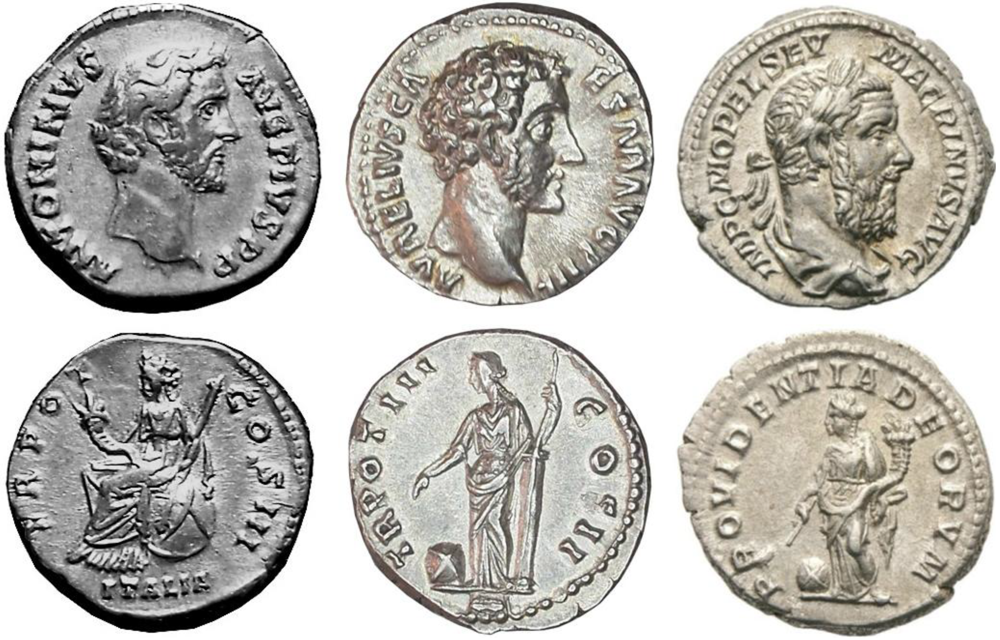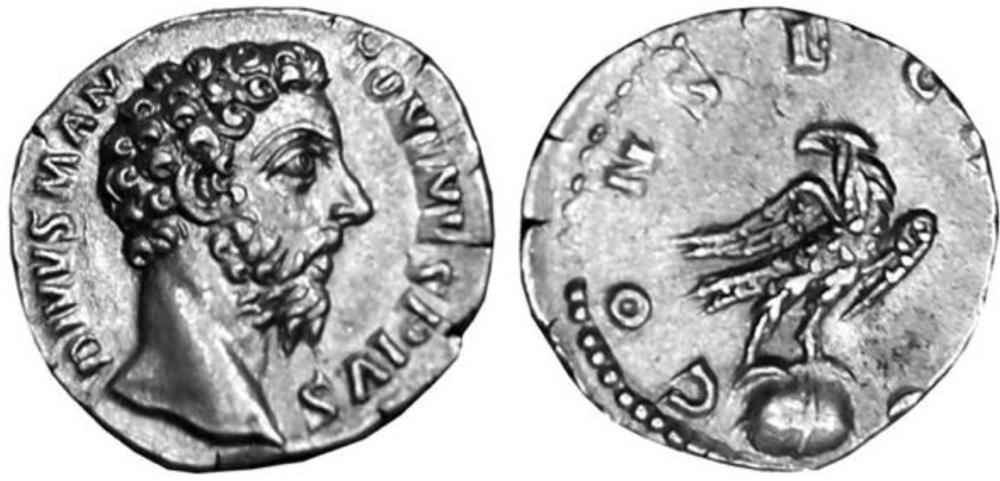Plato’s Visible God: The Cosmic Soul Reflected in the Heavens
Abstract
:1. The World Soul: Justin Martyr, Proclus and Plato
And the scientific discussion of the Son of God in his Timaeus—when he says: “He arranged him as an X in the whole”—Plato took from Moses, and spoke in similar terms.Justin Martyr, Apology on Behalf of Christians ([1], p. 235)
The shape X itself that results from the affixing [of the two strips] has the highest degree of appropriateness to the universe and to the soul.Proclus, Commentary on Plato’s Timaeus ([2], p. 233)
Next, he sliced this entire compound in two along its length, joined the two halves together center to center like an X, and bent them back in a circle, attaching each half to itself end to end and to the ends of the other half at the point opposite to the one where they had been joined together. He then included them in that motion which revolves in the same place without variation, and began to make one the outer, and the other the inner circle. And he decreed that the outer movement should be the movement of the Same, while the inner one should be that of the Different.Plato, Timaeus ([3], p. 21)
2. Modern and Ancient Mis-Interpretation
He now tilts the inner band, so that it makes an oblique angle with the outer, which is set at the horizontal; from which we see that the Revolution of the Same represents the celestial Equator, moving “horizontally to the right” (from East to West), and the Revolution of the Other represents the Ecliptic, which moves in a contrary direction to the Equator (from West to East), and at an angle to it. The Ecliptic He divides into seven, to represent the seven planets.Bury, Plato: Timaeus ([4], p. 72, n. 1)
Timaeus now speaks as if the Demiurge had made a long band of soul-stuff, marked off by the intervals of his scale. This he proceeds to slit lengthwise into two strips, which he puts together by their middles and bends round into two circles or rings, corresponding to the sidereal equator and the Zodiac.Cornford, Plato’s Cosmology ([5], p. 72)
Now surely two circles come into being, and these have come to be in such a way that one is on the inside and the other is on the outside, and they are at an angle to one another. Now one of these is called the circle of the Same and the other is the circle the Different. The one corresponds to the equator while the other corresponds to the circle of the ecliptic. The entire circle of the Different is carried around the ecliptic, while the circle of the Same is carried around the equator. Because of this it is immediately evident that it is not necessary to assume these circles to be at right angles to one another, but rather like an X, just as Plato said…Proclus, Commentary on Plato’s Timaeus ([2], p. 222).
And so now we may say that our account of the universe has reached its conclusion. This world of ours has received and teems with living things, mortal and immortal. A visible living thing containing visible ones, perceptible god, image of the intelligible Living Thing…Our one heaven, indeed the only one of its kind, has come to be.Plato, Timaeus ([3], p. 88)
3. Correct Interpretation
Now while the body of the universe had come to be as a visible thing, the soul was invisible.Plato, Timaeus ([3], p. 23)
Now when the Father who had begotten the universe observed it set in motion and alive, a thing that had come to be as a shrine for the everlasting gods, he was well pleased, and in his delight he thought of making it more like its model still. So, as the model was itself an everlasting Living Thing, he set himself to bringing this universe to completion in such a way that it, too, would have that character to the extent that was possible.Plato, Timaeus ([3], pp. 23–24)
When the god had finished making a body for each of them, he placed them into the orbits traced by the period of the Different—seven bodies in seven orbits.Plato, Timaeus ([3], p. 25)
To these [previous circles] you must add two circles which lie athwart and trace lines that cross each other. One contains the shining signs through which the Sun plies his reins, followed by the wandering Moon in her chariot, and wherein the five planets which struggle against the opposite movement of the sky perform the dances of their orbits that nature’s law diversifies… Nor does it elude the sight of the eye, as if it were a circle to be comprehended by the mind alone, even as the previous circles are perceived by the mind: nay, throughout its mighty circuit it shines like a baldric studded with stars and gives brilliance to heaven with its broad outline standing out in sharp relief.
The other circle [the Milky Way] is placed crosswise to it.Manilius, Astronomica ([8], pp. 57, 59)
4. Zodiacal Light and Milky Way
And you set up the images of your dead emperors on this pattern, and you name them gods through inscriptions.Justin Martyr, Apology on Behalf of Christians ([1], p. 227)



5. Conclusions
- 1. “The celestial equator and the ecliptic intersect at two points…” ([6], p. 47)
- 2. “The model… is essentially that established by Plato in the Timaeus… It even has its standard iconographic representation: the world globe with the crossed bands of equator and ecliptic/zodiac.” ([7], p. 79)
- 3. “Constantine was advised in a dream to mark the heavenly sign of God on the shields of his soldiers and then engage in battle. He did as he was commanded and by means of a slanted letter X with the top of its head bent around, he marked Christ on their shields. Armed with this sign, the army took up its weapons.”—Lactantius, De Mortibus Persecutorum ([11], p. 63)
- 4. “About the time of the midday sun, when day was just turning, he said he saw with his own eyes, up in the sky and resting over the sun, a cross-shaped trophy formed from light, and a text attached to it which said, ‘By this conquer’.” —Eusebius, Life of Constantine ([12], p. 81)
References
- Justin, Philosopher and Martyr: Apologies. D. Minns, and P. Parvis, eds. New York: Oxford University Press, 2009.
- Translated by D. Baltzly. Proclus: Commentary on Plato’s Timaeus: Volume 4, Book 3, Part 2, Proclus on the World Soul. New York: Cambridge University Press, 2009.
- Translated by D.J. Zeyl. Plato: Timaeus. Indianapolis: Hackett Publishing Company, 2000.
- Translated by R.G. Bury. Plato: Timaeus, Critias, Cleitophon, Menexenus, Epistles. Cambridge: Harvard University Press, 1929.
- F.M. Cornford. Plato’s Cosmology: The Timaeus of Plato. London: K. Paul, Trench, Trubner, 1937. [Google Scholar]
- D. Ulansey. The Origins of the Mithraic Mysteries. New York: Oxford University Press, 1989. [Google Scholar]
- R. Beck. The Religion of the Mithras Cult in the Roman Empire. New York: Oxford University Press, 2006. [Google Scholar]
- Translated by G.P. Goold. Manilius: Astronomica. Cambridge: Harvard University Press, 1977.
- H. Mattingly, and E.A. Sydenham. The Roman Imperial Coinage: Antoninus Pius to Commodius. London: Spink & Son, 1930, Volume III. [Google Scholar]
- H. Mattingly, E.A. Sydenham, and C.H.V. Sutherland. The Roman Imperial Coinage: Macrinus to Pupienus. London: Spink & Son, 1938, Volume IV, Part 2. [Google Scholar]
- J.L. Creed. Lactantius: De Mortibus Persecutorum. New York: Oxford University Press, 1984. [Google Scholar]
- Translated by A. Cameron, and S.G. Hall. Eusebius: Life of Constantine. New York: Oxford University Press, 1999.
© 2012 by the authors; licensee MDPI, Basel, Switzerland. This article is an open-access article distributed under the terms and conditions of the Creative Commons Attribution license (http://creativecommons.org/licenses/by/3.0/).
Share and Cite
Latura, G. Plato’s Visible God: The Cosmic Soul Reflected in the Heavens. Religions 2012, 3, 880-886. https://doi.org/10.3390/rel3030880
Latura G. Plato’s Visible God: The Cosmic Soul Reflected in the Heavens. Religions. 2012; 3(3):880-886. https://doi.org/10.3390/rel3030880
Chicago/Turabian StyleLatura, George. 2012. "Plato’s Visible God: The Cosmic Soul Reflected in the Heavens" Religions 3, no. 3: 880-886. https://doi.org/10.3390/rel3030880



